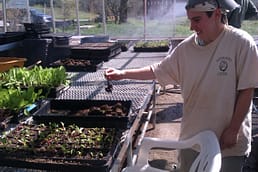We are excited to have Samantha Sheehan, our Education Assistant here at the farm, write a guest blog post:

Having the greenhouse/new building at the farm is nice, since we can start a lot of our own plants. Before our greenhouse, we had to go somewhere else to get them, since we didn’t have the space to start such plants from seed.
In the greenhouse, I’ve been assisting with the tranplanting of a vegetable called rainbow chard. The variety is called “rainbow” because of the colorful stem. Before you plant, you want to grab a section of the chard plants. Then you want to separate the plants that are multiple. After separating the plants, you want to take out any plants that are too small or the plants that have yellow leaves.
When planting the chard make sure there is only one plant in each cell. Also, you want to make sure the dirt is packed around the plant so the plant can stand up (if not enough dirt is around the plant the plant won’t stand up straight) . No roots want to be showing. As you take it from the flat, make sure you take the plant carefully by the leaf not the stem (if the plant is taken from the flat by the stem the stem will break). While separating the chard plants, make sure each plant still has some roots attached. I thought the transplanting of the chard was relatively easy, the thing I found a little difficult was separating two plants so each plant still had some roots attached.
When the chard is harvested, the biggest leaves (six or eight, depending on the size) are picked then put into a bunch (with no big holes or some small holes). After the bunch is picked, it is rubber banded, then the stems are cut. The bunches are then placed into a basket and brought down to the barn. After the bunches are brought to the barn they are misted with the hose then placed into a box. Once this happens, the boxes go into the refrigerator.
At times, after planting the chard, we’ve covered it using something called remay (or row cover). This helps keep the plants warm as well as keeping most bugs out. Using remay doesn’t keep ALL bugs out, though it does help a bit in terms of bug holes in each leaf.


